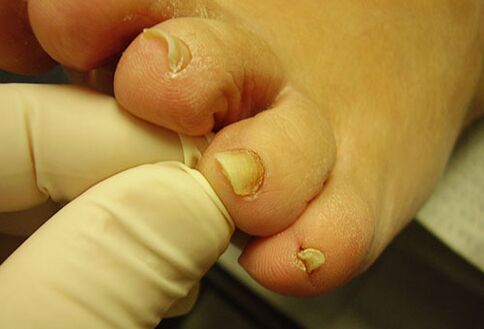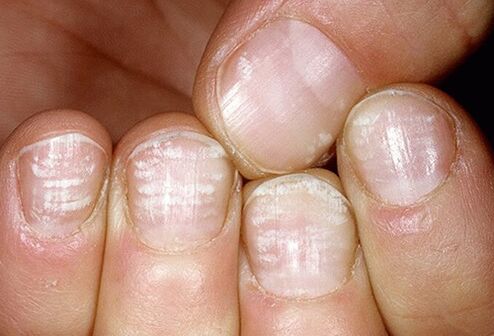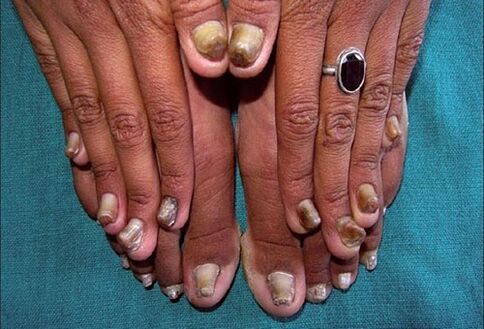Fungal nail disease cannot be confused with any disease when it is in a severe stage, when the disease is almost incurable. But if you know the symptoms of nail fungus earlier, it's not too late to start fighting the infection and possibly avoid nail loss. But in different cases, the fungus looks different, so you must first understand a little about the nature and course of the disease.

General signs of the disease
Regardless of the fungus, type, course of the disease, and even the stage, these symptoms will not change and are definitely signs of onychomycosis developing or already present.
- A change in the color of the nails is the main sign that the disease has begun to develop. Shades can range from white to black, but the most common color of nail fungus is golden brown.
- An unpleasant odor always accompanies nail fungus, although it may go unnoticed in the early stages. Yes, you will barely smell your feet, and a specific odor will become noticeable at an advanced stage of the disease.
- Stratification, crumbling, and peeling of the nails don't start immediately, but it's these signs of nail fungus that raise the alarm for most people. If these symptoms are mild and only localized, there is a good chance that the nail will return to a healthy appearance.
- Pain is rarely present in the early and advanced stages of development, but as the disease progresses, discomfort and pain are inevitable: in any case, it will appear due to deformity, or becausenail plate destruction, or the onset of purulent inflammation.
- Burnt and itchy skin should also not be ignored. Moreover, in the early stages, it is these symptoms that can help identify the disease, since in some cases it is transmitted to the nail plate from the skin in the lateral or posterior ridges or epidermis.
By the way
Toenail fungus is much more common on toenails, while fungus on the hands is less frequent, usually after contact with the affected toenail.

Symptoms of foot fungus
It may sound like you already know how to recognize toenail fungus, but this information is rather general, although it will help make an accurate diagnosis of toenail fungus. The fact is that there are more than 50 species of fungi that can cause this disease and about 10 cases of the disease. It's better to know in advance what awaits you in each possible situation.
More than 90% of all toenail infections are caused by dermatophytes, less than 10% - by yeast-like fungi, and only a small percentage - by molds.
Different types of nail fungus provide different symptoms.
- With a normal fungus, the nail plate itself is not deformed, and the most noticeable manifestation of the disease is a change in the color of the patches on the sides to yellow-brown. At the same time, its thickness does not change, does not crumble, and the natural gloss does not disappear. If the dong quai fungus is not treated, it will affect an increasingly large area, the plaque will begin to peel off and may fall off completely.
- Hypertrophic fungi cause thickening of the nail plate, leading to the formation of claw-like growths. In the advanced stage, this fungus causes discomfort and often pain when walking, and of course, nail damage accompanied by a color change to gray or yellow. Such nails lose their natural shine and begin to crack and peel.
- If you are dealing with powdery mildew, the risk of losing your discs without treatment is extremely high. This fungus gradually destroys the nail, causing the nail to become loose and scaly, resulting in nail atrophy. In the early stages, it is difficult to distinguish the process of skin atrophy, since it is accompanied only by a loss of luster and a change in the color of the plaque to yellow, brown or gray.
Less typical are distal lateral mold with blackening of the nail plate, pain, scaling and atrophy of the nail plate in the advanced stage; a fungus close to white spots in the area that grows and damages the nail plate from the side of the cuticle, as well as a white superficial fungus, manifested as small white spots on the nail, largegradually and occupies an increasingly large area.
By the way
The older you get, the more susceptible you are to nail fungus. In addition, the occurrence of fungi can be influenced by climate, hygiene and gender.

Symptoms of fungus on hands
In the hands, the three main variants of the disease process do not differ from those encountered in the legs, only the distribution of causative agents is slightly different: approximately 30% and 45% are due to dermatophytosis and yeast-like. fungi, respectively, less than 15% are molds, and a small number of infections are caused by other mycotic organisms.
The main symptoms are also the same for the patches on the arms and legs, and the affected areas look similar. The only difficult point may be the question of how to recognize nail fungus in less frequent cases, such as infection with rubromycosis or trichophytons, but this is the task of qualified physicians.

The evolution of fungi
If in the early stages, the disease does not seem scary and the treatment is serious, there are few visits, and it is increasingly replaced by folk methods, then in the severe stage, it will not be cured without long-term treatment. long. And it won't even be able to guarantee that the nail will stay with you.
- It would be ideal to start treating the disease at an early stage, but it is almost impossible to identify the disease outside the laboratory: all symptoms are barely noticeable. Although there are still some signs to be seen. If you notice something wrong with your skin, such as cracks, blisters, or burning that may appear, this is a clear sign of onychomycosis on your nails. If you see nail color starting to change along the edges or from one edge, this is also a cause for concern.
- Usually, the fungus becomes noticeable at an advanced stage, and to recognize it as early as possible, you need to regularly do at least a simple pedicure and monitor the condition of the fingernails and toenails. . During this stage, the nails look unhealthy, lose their shine, the color begins to change dramatically, and closer to the more severe stage, the nails begin to deform, peel and crumble.
- In the severe stage, the nail will definitely actively collapse: split, break, loose leading to destruction of the entire nail plate and even damage to the nail layer. In order for the disease to progress to a serious stage, it takes a long time to pass, suffering from itching, discomfort, disgusting appearance and bad smell is something that people still do not often do. Therefore, this period is typical for the rapid growth of fungi in old age or in the presence of certain diseases.
It should be remembered that nail fungus that is not treated in time can turn into tinea pedis, and this disease is even more uncomfortable and difficult to treat.
It's not too difficult to determine the presence of fungus on your nails at least in the growing stage, but you're better off entrusting a qualified professional to determine the cause and type of fungus. Do not ignore the help of the doctor and contact them at the first suspicion of illness.


























